International Finance: An In-Depth Review of European Currency Options
VerifiedAdded on 2022/08/14
|5
|1214
|12
Report
AI Summary
This memorandum provides an in-depth review of European currency options. It defines currency options and European options, explaining their functionality and use for hedging and speculation. The report explores call and put options, detailing how investors can profit from market movements. It highlights the application of the Black-Scholes model in valuing these options and the importance of arbitrage theory in currency option contracts. The report also discusses put-call parity and its implications, along with the use of the Black-Scholes-Merton model in the interbank market and its influence on derivatives trading. Key concepts such as volatility and option pricing are examined, providing a comprehensive understanding of European currency options and their role in international finance.
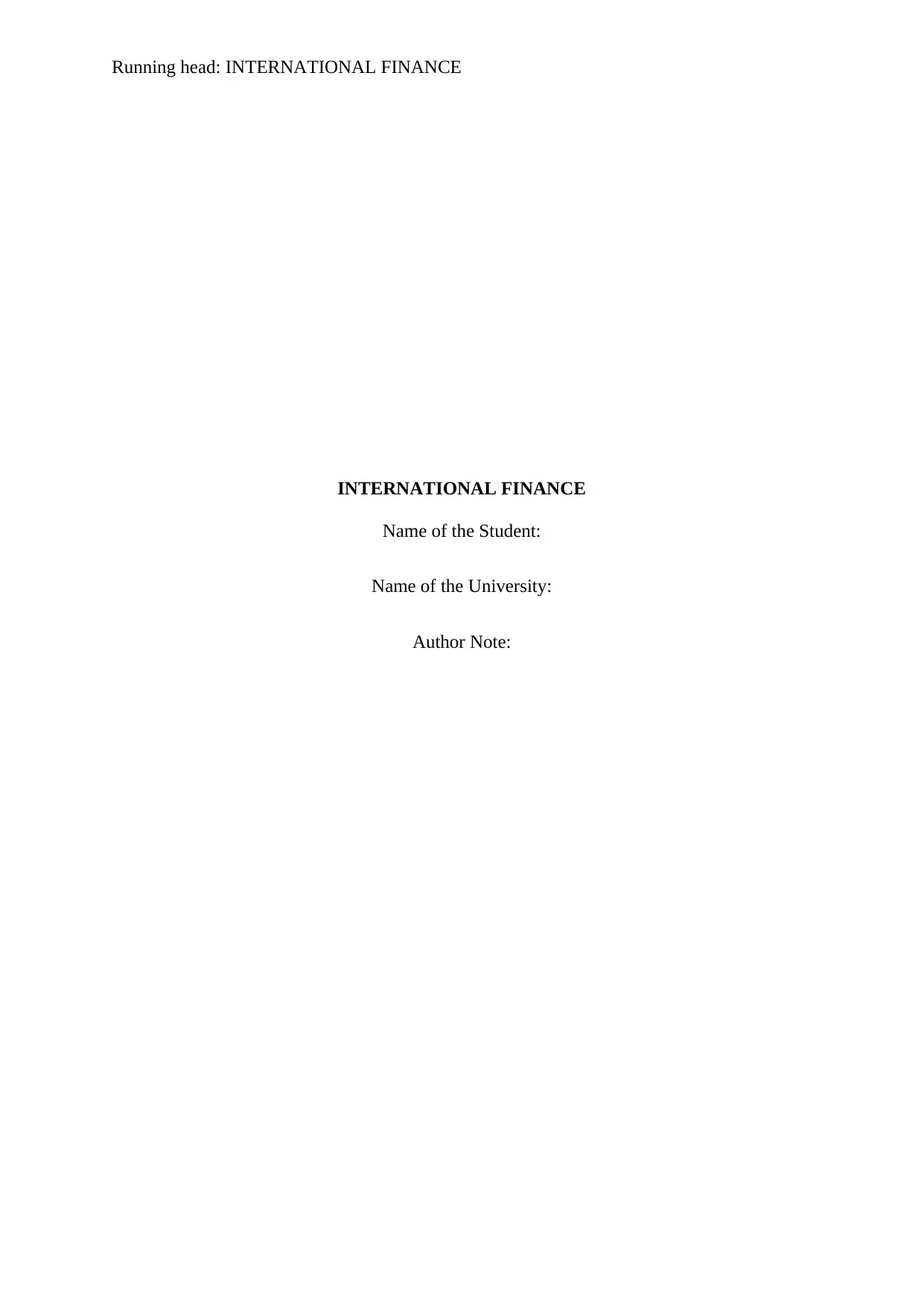
Running head: INTERNATIONAL FINANCE
INTERNATIONAL FINANCE
Name of the Student:
Name of the University:
Author Note:
INTERNATIONAL FINANCE
Name of the Student:
Name of the University:
Author Note:
Paraphrase This Document
Need a fresh take? Get an instant paraphrase of this document with our AI Paraphraser
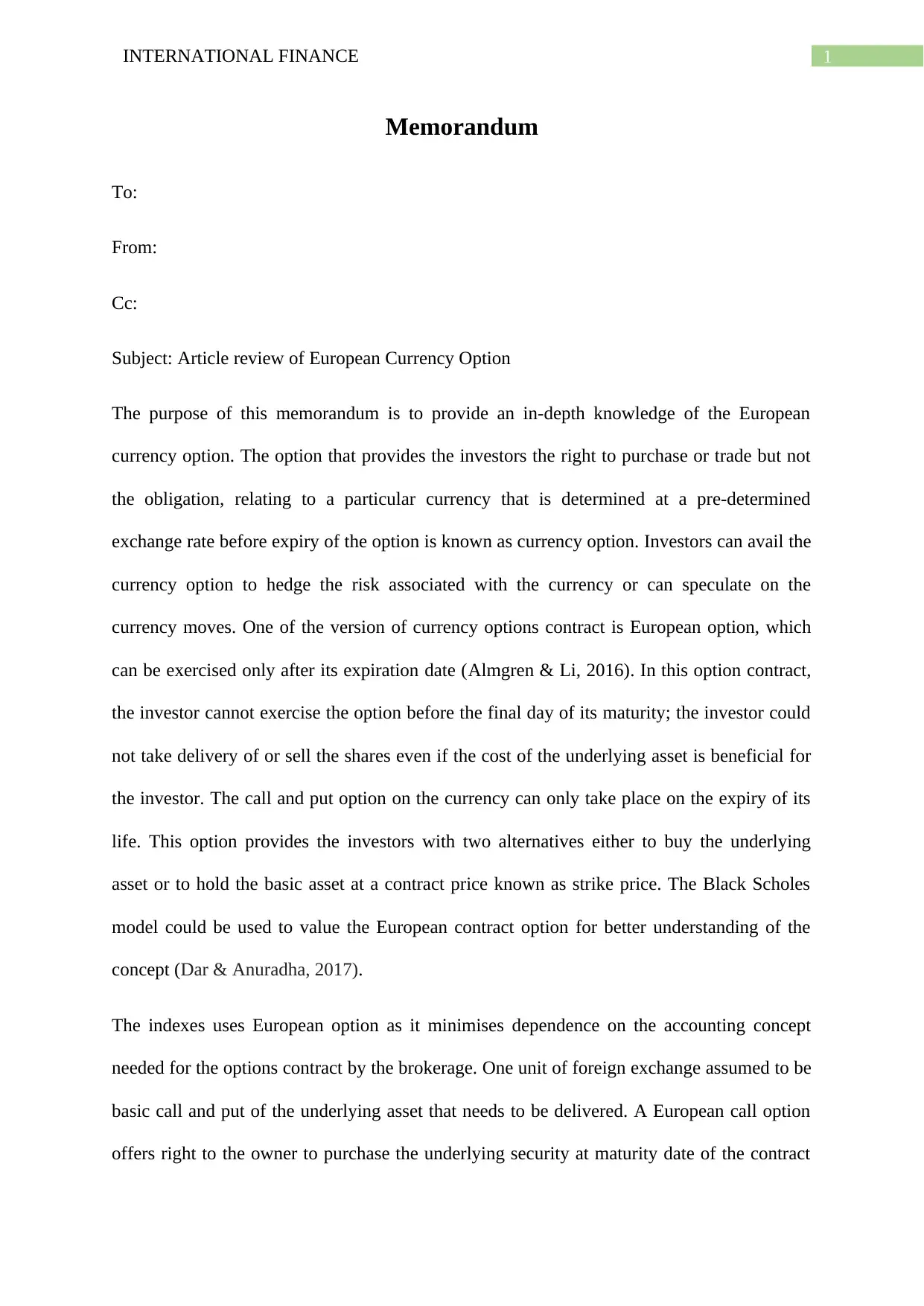
1INTERNATIONAL FINANCE
Memorandum
To:
From:
Cc:
Subject: Article review of European Currency Option
The purpose of this memorandum is to provide an in-depth knowledge of the European
currency option. The option that provides the investors the right to purchase or trade but not
the obligation, relating to a particular currency that is determined at a pre-determined
exchange rate before expiry of the option is known as currency option. Investors can avail the
currency option to hedge the risk associated with the currency or can speculate on the
currency moves. One of the version of currency options contract is European option, which
can be exercised only after its expiration date (Almgren & Li, 2016). In this option contract,
the investor cannot exercise the option before the final day of its maturity; the investor could
not take delivery of or sell the shares even if the cost of the underlying asset is beneficial for
the investor. The call and put option on the currency can only take place on the expiry of its
life. This option provides the investors with two alternatives either to buy the underlying
asset or to hold the basic asset at a contract price known as strike price. The Black Scholes
model could be used to value the European contract option for better understanding of the
concept (Dar & Anuradha, 2017).
The indexes uses European option as it minimises dependence on the accounting concept
needed for the options contract by the brokerage. One unit of foreign exchange assumed to be
basic call and put of the underlying asset that needs to be delivered. A European call option
offers right to the owner to purchase the underlying security at maturity date of the contract
Memorandum
To:
From:
Cc:
Subject: Article review of European Currency Option
The purpose of this memorandum is to provide an in-depth knowledge of the European
currency option. The option that provides the investors the right to purchase or trade but not
the obligation, relating to a particular currency that is determined at a pre-determined
exchange rate before expiry of the option is known as currency option. Investors can avail the
currency option to hedge the risk associated with the currency or can speculate on the
currency moves. One of the version of currency options contract is European option, which
can be exercised only after its expiration date (Almgren & Li, 2016). In this option contract,
the investor cannot exercise the option before the final day of its maturity; the investor could
not take delivery of or sell the shares even if the cost of the underlying asset is beneficial for
the investor. The call and put option on the currency can only take place on the expiry of its
life. This option provides the investors with two alternatives either to buy the underlying
asset or to hold the basic asset at a contract price known as strike price. The Black Scholes
model could be used to value the European contract option for better understanding of the
concept (Dar & Anuradha, 2017).
The indexes uses European option as it minimises dependence on the accounting concept
needed for the options contract by the brokerage. One unit of foreign exchange assumed to be
basic call and put of the underlying asset that needs to be delivered. A European call option
offers right to the owner to purchase the underlying security at maturity date of the contract
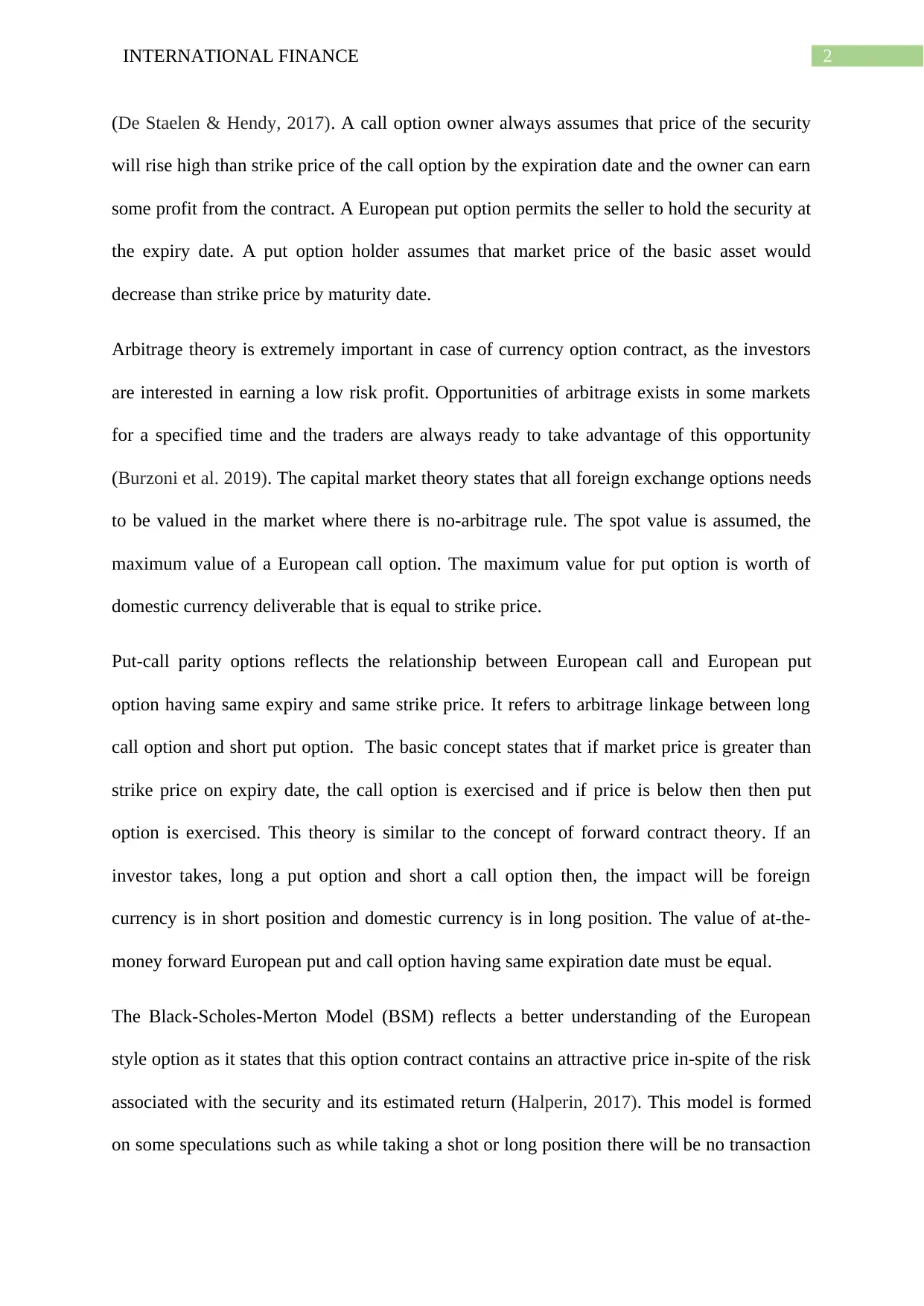
2INTERNATIONAL FINANCE
(De Staelen & Hendy, 2017). A call option owner always assumes that price of the security
will rise high than strike price of the call option by the expiration date and the owner can earn
some profit from the contract. A European put option permits the seller to hold the security at
the expiry date. A put option holder assumes that market price of the basic asset would
decrease than strike price by maturity date.
Arbitrage theory is extremely important in case of currency option contract, as the investors
are interested in earning a low risk profit. Opportunities of arbitrage exists in some markets
for a specified time and the traders are always ready to take advantage of this opportunity
(Burzoni et al. 2019). The capital market theory states that all foreign exchange options needs
to be valued in the market where there is no-arbitrage rule. The spot value is assumed, the
maximum value of a European call option. The maximum value for put option is worth of
domestic currency deliverable that is equal to strike price.
Put-call parity options reflects the relationship between European call and European put
option having same expiry and same strike price. It refers to arbitrage linkage between long
call option and short put option. The basic concept states that if market price is greater than
strike price on expiry date, the call option is exercised and if price is below then then put
option is exercised. This theory is similar to the concept of forward contract theory. If an
investor takes, long a put option and short a call option then, the impact will be foreign
currency is in short position and domestic currency is in long position. The value of at-the-
money forward European put and call option having same expiration date must be equal.
The Black-Scholes-Merton Model (BSM) reflects a better understanding of the European
style option as it states that this option contract contains an attractive price in-spite of the risk
associated with the security and its estimated return (Halperin, 2017). This model is formed
on some speculations such as while taking a shot or long position there will be no transaction
(De Staelen & Hendy, 2017). A call option owner always assumes that price of the security
will rise high than strike price of the call option by the expiration date and the owner can earn
some profit from the contract. A European put option permits the seller to hold the security at
the expiry date. A put option holder assumes that market price of the basic asset would
decrease than strike price by maturity date.
Arbitrage theory is extremely important in case of currency option contract, as the investors
are interested in earning a low risk profit. Opportunities of arbitrage exists in some markets
for a specified time and the traders are always ready to take advantage of this opportunity
(Burzoni et al. 2019). The capital market theory states that all foreign exchange options needs
to be valued in the market where there is no-arbitrage rule. The spot value is assumed, the
maximum value of a European call option. The maximum value for put option is worth of
domestic currency deliverable that is equal to strike price.
Put-call parity options reflects the relationship between European call and European put
option having same expiry and same strike price. It refers to arbitrage linkage between long
call option and short put option. The basic concept states that if market price is greater than
strike price on expiry date, the call option is exercised and if price is below then then put
option is exercised. This theory is similar to the concept of forward contract theory. If an
investor takes, long a put option and short a call option then, the impact will be foreign
currency is in short position and domestic currency is in long position. The value of at-the-
money forward European put and call option having same expiration date must be equal.
The Black-Scholes-Merton Model (BSM) reflects a better understanding of the European
style option as it states that this option contract contains an attractive price in-spite of the risk
associated with the security and its estimated return (Halperin, 2017). This model is formed
on some speculations such as while taking a shot or long position there will be no transaction
⊘ This is a preview!⊘
Do you want full access?
Subscribe today to unlock all pages.

Trusted by 1+ million students worldwide
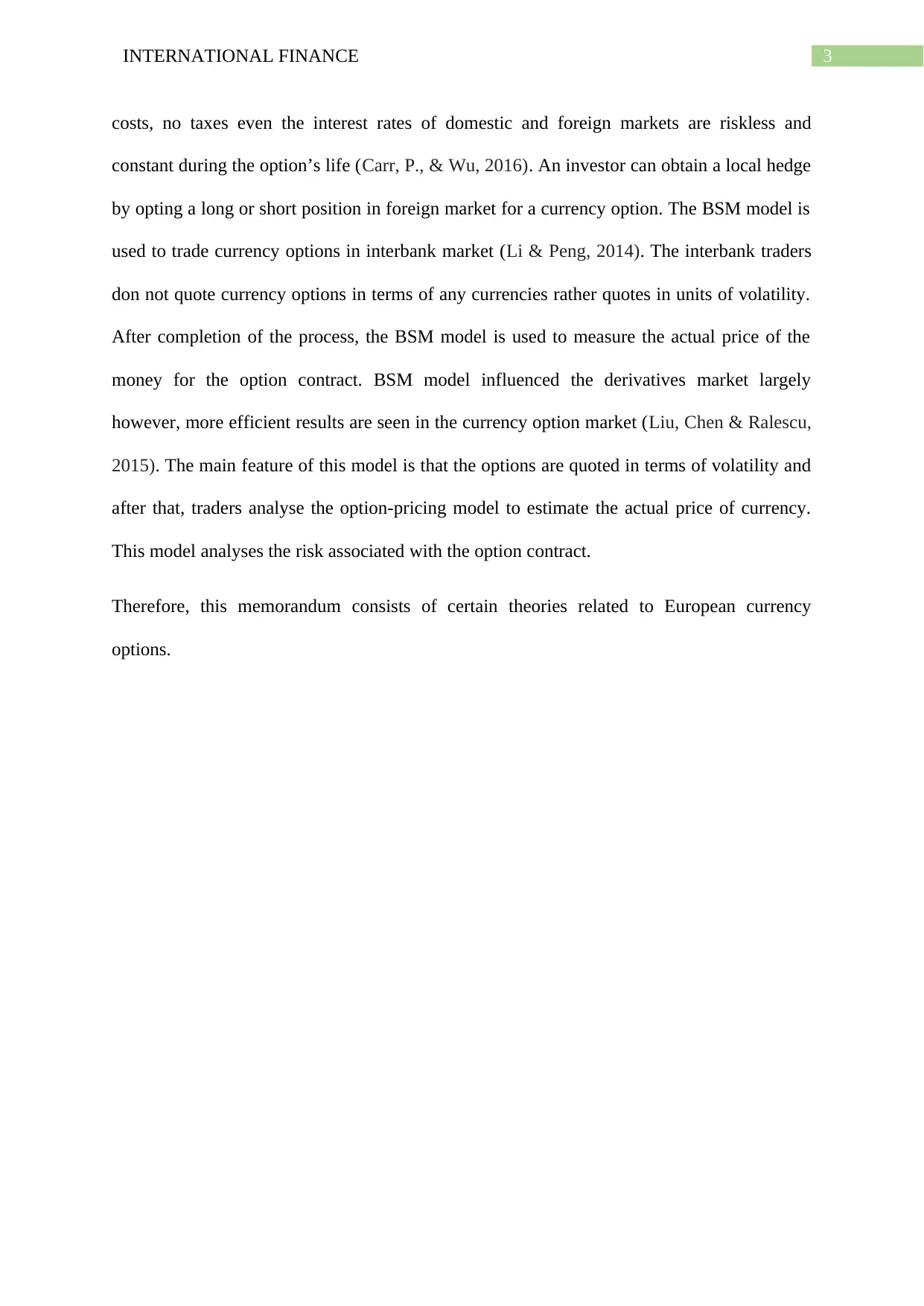
3INTERNATIONAL FINANCE
costs, no taxes even the interest rates of domestic and foreign markets are riskless and
constant during the option’s life (Carr, P., & Wu, 2016). An investor can obtain a local hedge
by opting a long or short position in foreign market for a currency option. The BSM model is
used to trade currency options in interbank market (Li & Peng, 2014). The interbank traders
don not quote currency options in terms of any currencies rather quotes in units of volatility.
After completion of the process, the BSM model is used to measure the actual price of the
money for the option contract. BSM model influenced the derivatives market largely
however, more efficient results are seen in the currency option market (Liu, Chen & Ralescu,
2015). The main feature of this model is that the options are quoted in terms of volatility and
after that, traders analyse the option-pricing model to estimate the actual price of currency.
This model analyses the risk associated with the option contract.
Therefore, this memorandum consists of certain theories related to European currency
options.
costs, no taxes even the interest rates of domestic and foreign markets are riskless and
constant during the option’s life (Carr, P., & Wu, 2016). An investor can obtain a local hedge
by opting a long or short position in foreign market for a currency option. The BSM model is
used to trade currency options in interbank market (Li & Peng, 2014). The interbank traders
don not quote currency options in terms of any currencies rather quotes in units of volatility.
After completion of the process, the BSM model is used to measure the actual price of the
money for the option contract. BSM model influenced the derivatives market largely
however, more efficient results are seen in the currency option market (Liu, Chen & Ralescu,
2015). The main feature of this model is that the options are quoted in terms of volatility and
after that, traders analyse the option-pricing model to estimate the actual price of currency.
This model analyses the risk associated with the option contract.
Therefore, this memorandum consists of certain theories related to European currency
options.
Paraphrase This Document
Need a fresh take? Get an instant paraphrase of this document with our AI Paraphraser
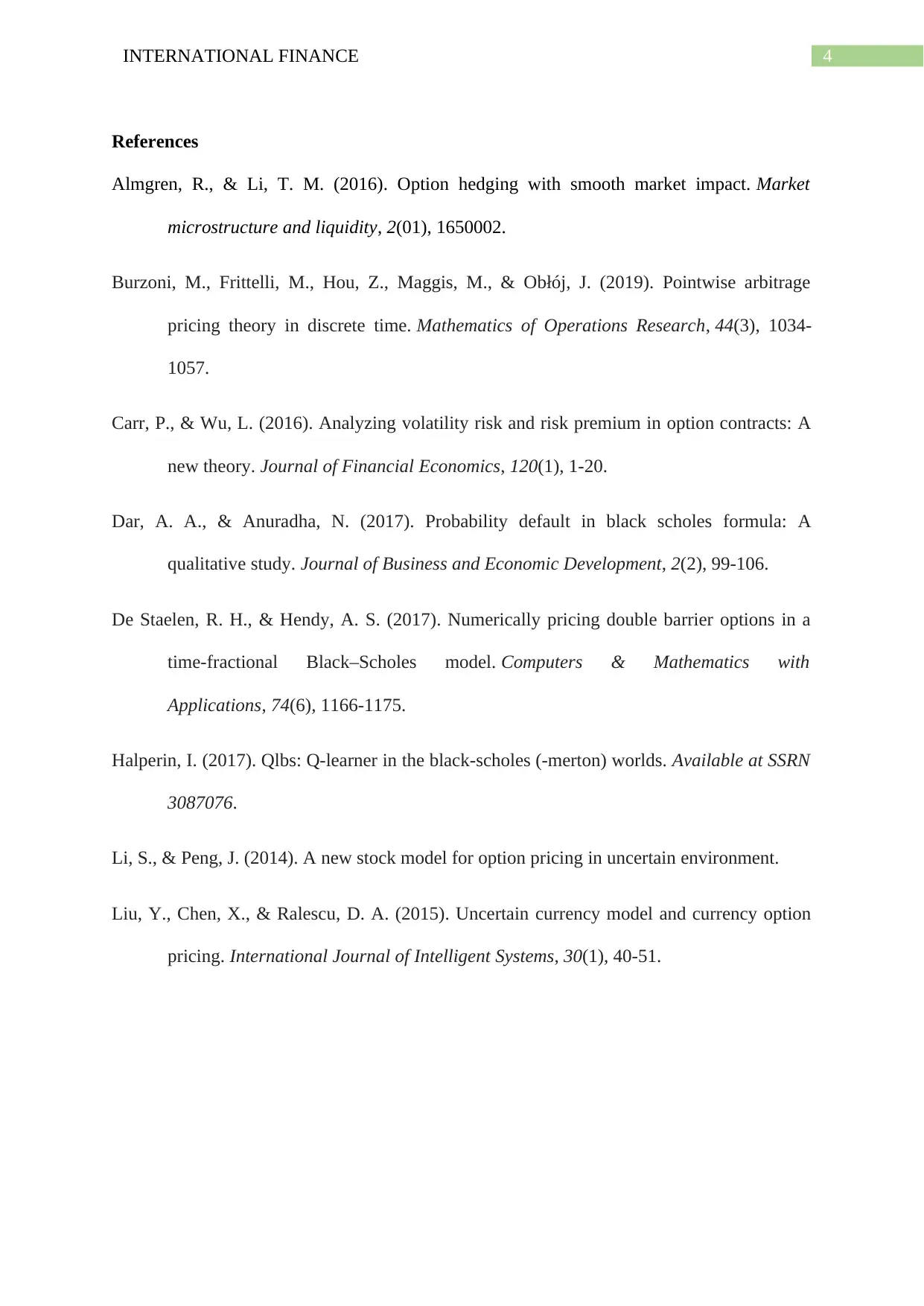
4INTERNATIONAL FINANCE
References
Almgren, R., & Li, T. M. (2016). Option hedging with smooth market impact. Market
microstructure and liquidity, 2(01), 1650002.
Burzoni, M., Frittelli, M., Hou, Z., Maggis, M., & Obłój, J. (2019). Pointwise arbitrage
pricing theory in discrete time. Mathematics of Operations Research, 44(3), 1034-
1057.
Carr, P., & Wu, L. (2016). Analyzing volatility risk and risk premium in option contracts: A
new theory. Journal of Financial Economics, 120(1), 1-20.
Dar, A. A., & Anuradha, N. (2017). Probability default in black scholes formula: A
qualitative study. Journal of Business and Economic Development, 2(2), 99-106.
De Staelen, R. H., & Hendy, A. S. (2017). Numerically pricing double barrier options in a
time-fractional Black–Scholes model. Computers & Mathematics with
Applications, 74(6), 1166-1175.
Halperin, I. (2017). Qlbs: Q-learner in the black-scholes (-merton) worlds. Available at SSRN
3087076.
Li, S., & Peng, J. (2014). A new stock model for option pricing in uncertain environment.
Liu, Y., Chen, X., & Ralescu, D. A. (2015). Uncertain currency model and currency option
pricing. International Journal of Intelligent Systems, 30(1), 40-51.
References
Almgren, R., & Li, T. M. (2016). Option hedging with smooth market impact. Market
microstructure and liquidity, 2(01), 1650002.
Burzoni, M., Frittelli, M., Hou, Z., Maggis, M., & Obłój, J. (2019). Pointwise arbitrage
pricing theory in discrete time. Mathematics of Operations Research, 44(3), 1034-
1057.
Carr, P., & Wu, L. (2016). Analyzing volatility risk and risk premium in option contracts: A
new theory. Journal of Financial Economics, 120(1), 1-20.
Dar, A. A., & Anuradha, N. (2017). Probability default in black scholes formula: A
qualitative study. Journal of Business and Economic Development, 2(2), 99-106.
De Staelen, R. H., & Hendy, A. S. (2017). Numerically pricing double barrier options in a
time-fractional Black–Scholes model. Computers & Mathematics with
Applications, 74(6), 1166-1175.
Halperin, I. (2017). Qlbs: Q-learner in the black-scholes (-merton) worlds. Available at SSRN
3087076.
Li, S., & Peng, J. (2014). A new stock model for option pricing in uncertain environment.
Liu, Y., Chen, X., & Ralescu, D. A. (2015). Uncertain currency model and currency option
pricing. International Journal of Intelligent Systems, 30(1), 40-51.
1 out of 5
Related Documents
Your All-in-One AI-Powered Toolkit for Academic Success.
+13062052269
info@desklib.com
Available 24*7 on WhatsApp / Email
![[object Object]](/_next/static/media/star-bottom.7253800d.svg)
Unlock your academic potential
Copyright © 2020–2025 A2Z Services. All Rights Reserved. Developed and managed by ZUCOL.





